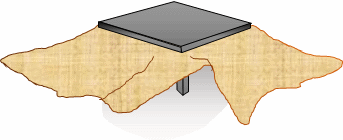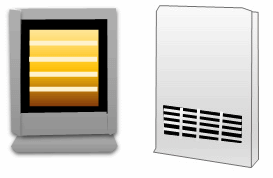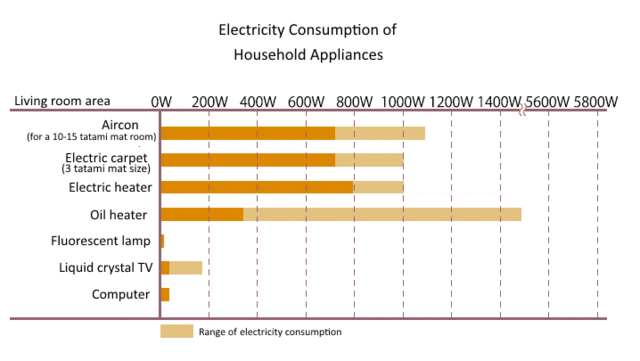Electric Heating

Kotatsu Table (こたつ、kotatsu)
The kotatsu is a Japanese tradition spanning hundreds of years. In its modern form, a small, low table is affixed with a heating element (usually electric) underneath. A thick blanket is then sandwiched between the table and the table top. Sitting at this table can keep you warm even if the rest of the room is cold, and many families gather around the table in the winter. Be careful of sleeping under the kotatsu though; you might catch a cold! And unfortunately, a kotatsu will never be able to heat a whole room up.
Kotatsu tips
-Wear a sweater or cardigan to keep the upper half of your body warm.
-Don’t turn the temperature up too high when using the kotatsu in conjunction with other heaters.
Saving Energy
- Keep a blanket or area rug underneath the kotatsu to boost its heating potential.
During 1 year you’ll save…
- 32.48 kWh of electricity:Around 710 yen
- 11.4 kg of CO2 output
- Equivalent of 8.19 liters of oil
(when using a kotatsu for 5 hours a day)
-Turn the temperature down from high to medium.
During 1 year you’ll save…
- 48.95 kWh of electricity:Around 1,080 yen
- 17.1 kg of CO2 output
- Equivalent of 12.34 liters of oil
(when using a kotatsu for 5 hours a day)
References:
Energy Conservation Center
Air conditioner (エアコン, eakon)
These units will efficiently heat your room and can also be used for cooling in the summer. As a huge bonus, their dehumidifier features will suck the moisture out of the air. As we all know, Japan is a very humid climate, and moisture can damage the walls and window frames, and worst it can lead to mold growth. Aircons can help you eliminate this problem, but the installation costs are quite high.
Aircon tips
-Don’t open doors or windows unless you have to.
-Use thick curtains that reach down to the floor over your windows.
-Use the aircon with a fan to evenly distribute the warm air.
-Clean your filters to keep your aircon efficient. Vacuum dust particles and wash the filters with lukewarm water before letting them dry completely.
-Turn your aircon off around 15 minutes before you have to leave or go to sleep.
Saving Energy
- Keep your aircon set to 20°C.
During 1 year you’ll save…
- 53.08 kWh of electricity:Around 1,170 yen
- 18.6 kg of CO2 output
- Equivalent of 13.38 liters of oil
(When using the aircon 9 hours a day, outside temperatures are 6°C, and you have set your aircon to 20°from 21°)
-Only use the aircon when you need it.
During 1 year you’ll save…
- 40.73 kWh of electricity:Around 900 yen
- 14.3 kg of CO2 output
- Equivalent of 10.26 liters of oil
(When reducing aircon usage one hour a day, at a temperature of 20°)
-Clean your filter 1-2 times a month.
During 1 year you’ll save…
- 31.95 kWh of electricity:Around 700 yen
- 11.2 kg of CO2 output
- Equivalent of 8.05 liters of oil
(Compared to a clogged aircon)
Click here for a comparison of aircon models produced by the Agency of Natural Resources and Energy. (JPN only)
References:
Energy Conservation Center
Heated carpets (ホットカーペット, hotto kaapetto)
Cheap to run and useful especially if you have a Japanese-style room (tatami flooring).
Carpet Tips
-Lay the carpet on top of foam insulation (found in 100-yen shops) to increase its efficiency.
-Many carpets can set to heat only in sections. Only heat the section that you are using - you don’t have to heat the whole thing.
Saving Energy
- Use a carpet big enough for the room.
During 1 year you’ll save…
- 89.91 kWh of electricity:Around 1,980 yen
- 31.5 kg of CO2 output
- Equivalent of 22.66 liters of oil
(Comparing a 3-jo carpet with a 2-jo carpet, used 5 hours a day, at medium setting, and a room temperature of 20°C)
*2-jo = 2 tatami mats, or around 2m x 2m
*3-jo = 3 tatami mats, or around 2m x 3m
- Turn the temperature down from high to medium.
During 1 year you’ll save…
- 185.97 kWh of electricity:Around 4,090 yen
- 65.1 kg of CO2 output
- Equivalent of 46.86 liters of oil
(When using a 3-jo carpet 5 hours a day)
References:
Energy Conservation Center
Other electric heating methods
Electric blanket (電気毛布, denki mofu)
You can use electric blankets to heat up your futon or bed before sleeping, but try not to sleep with the heater on.
Electric space heaters (電気ストーブ, denki sutobu)
There are many different types to choose from, and a wide range of prices. Space heaters are useful for spot heating, but are not good at heating up a whole room.
Types of electric heaters:
Halogen (ハロゲンヒーター, harogen hiitaa)
Infrared (赤外線ストーブ, sekigaisen sutobu)
Ceramic (セラミックヒーター, seramikku hiitaa)
Carbon (カーボンヒーター, caabon hiitaa)
Oil heater (オイルヒーター, oiru hiitaa)

Floor heating (床暖房、yuka danbo)
This type of flooring (usually wood flooring) can be heated to protect a level of warmth throughout your home.
Remember to turn it off 30 minutes before leaving your home or going to bed to conserve energy.
Electricity Usage Comparison
Use this graph produced by the Real Estate Companies Association of Japan to compare energy usages by various heating methods.
You can also visit the Energy-Saving Product Information produced by the Agency for Natural Resources and Energy by going here:

This is just a set example of energy consumption. These rates may change depending on different brands and models, and the way you use them.
Source: Agency for Natural Resources and Energy
Reference:
Real Estate Companies Association of Japan
このページに関するお問い合わせ
Office of International Affairs, Department of Homeland Promotion
(020-8570) 10-1 Uchimaru, Morioka City, Iwate Prefecture, JAPAN
Phone number:019-629-5765 Facsimile:019-629-5254
You can access our question form here.

